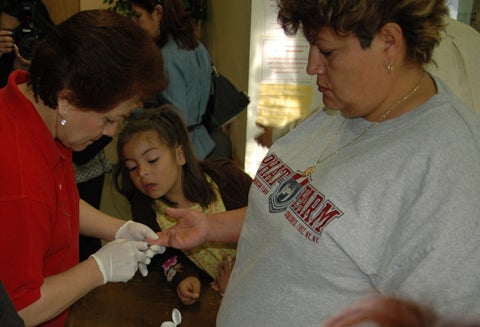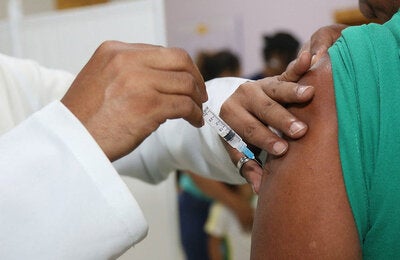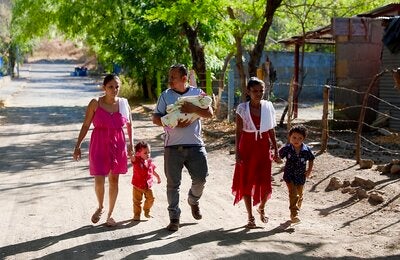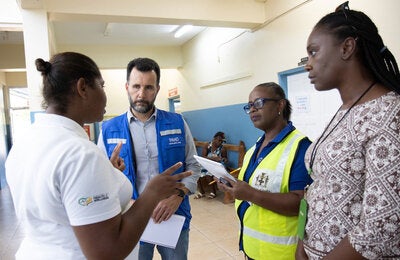
 For every three people diagnosed with diabetes along the U.S.—Mexico border, a fourth person has the condition but doesn't know it, putting them at increased risk of heart disease and stroke as well as blindness, kidney failure, and amputations, according to studies published in the latest issue of the Pan American Journal of Public Health.
For every three people diagnosed with diabetes along the U.S.—Mexico border, a fourth person has the condition but doesn't know it, putting them at increased risk of heart disease and stroke as well as blindness, kidney failure, and amputations, according to studies published in the latest issue of the Pan American Journal of Public Health.
Border inhabitants are 2—3 times more likely to have diabetes, but many are unaware of the condition, according to a special issue of the Pan American Journal of Public Health
Washington, D.C., October 21, 2010 (PAHO) — For every three people diagnosed with diabetes along the U.S.—Mexico border, a fourth person has the condition but doesn't know it, putting them at increased risk of heart disease and stroke as well as blindness, kidney failure, and amputations, according to studies published in the latest issue of the Pan American Journal of Public Health.

Type 2 diabetes is about 2—3 times more prevalent in the border area than in the rest of the United States or Mexico. Some 15.7 percent of adults living along the border—about 1.2 million people—have diabetes, compared with 8.2 percent nationally in Mexico and 5.2 percent in the United States.
An additional 14 percent of adults living on the border—about 1 million people—are in a pre-diabetic stage. Some 300,000 in the area are unaware they have the disease.
The findings are reported in a special issue of the Pan American Journal of Public Health, PAHO's peer-reviewed scientific journal. The issue reports the results of the U.S.—Mexico Border Diabetes Prevention and Control Project, a binational research effort coordinated by the Pan American Health Organization/World Health Organization (PAHO/WHO) in collaboration with the U.S. Centers for Disease Control and Prevention (CDC), the ministry of health of Mexico, the Paso del Norte Health Foundation, and the California Endowment.
"DM2 [type 2 diabetes] is one of the most important and challenging public health problems in both Mexico and the United States," writes Dr. Maria Teresa Cerqueira, chief of PAHO's U.S. —Mexico Border Office and one of the lead researchers for the project. "In this sense, it might be considered as the tip of the iceberg when it comes to chronic disease patterns along the entire U.S.-Mexico border."
The findings are based on data collected between 2001 and 2002 in 16 U.S. counties and 28 Mexican municipalities. They show that 70 percent of border inhabitants who suffer from diabetes are overweight or obese, and only 30 percent engage in regular physical activity. Acculturation appears to decrease people's consumption of fruits and vegetables but increases their awareness of the importance of healthy lifestyle habits, particularly physical activity.
The studies also found that people of Mexican descent—on both sides of the border—are more likely to have diabetes but be unaware of it, as are people who lack health insurance or access to routine health care.
"The implication from our study is that public health policymakers should make efforts to increase access to diabetes-related preventive care," said Dr. Xuanping Zhang, a diabetes expert at the CDC and lead author of one of the studies. "We also should improve preventive care practice…. Individuals, communities, public health providers and healthcare systems should work together to find a way to prevent diabetes, for example, making preventive care more accessible, affordable, sustainable and attractive."
Among other key findings of the project are:
- Diabetes is inversely related to education and socioeconomic levels.
- Nearly 48 percent of diabetes sufferers have high blood pressure, but only one in four is receiving treatment for it.
- About 61 percent of diagnosed diabetes sufferers in the border area have at least one other family member with the disease, confirming family history as an important risk factor.
- Obesity appears to be a key factor in high rates of diabetes in the border area; more than one-third of border inhabitants are obese, and obese people are, in general, 2.5 times more likely to have diabetes than those of normal weight.
The project also found that the prevalence of undiagnosed diabetes among U.S. inhabitants along the border was lower than rates in the general U.S. population with diabetes—15 percent versus 30 percent, respectively. The researchers conclude that this may be due to greater awareness on the part of U.S. healthcare providers of the higher diabetes risk in the U.S. Hispanic versus non-Hispanic white populations.
The border diabetes project is the first research effort to treat the border as a single epidemiological unit. Researchers note that counties and municipalities on both sides of the border share more environmental, cultural and behavioral similarities with one another than they do with their own respective countries.
"Cultural myths are deeply ingrained among the border population, where expressions such as 'diabetes is inevitable; my parents and/or grandparents had DM2 [diabetes type 2] and now I have it' are frequently heard," notes Dr. Cerqueira. "This attitude is a consequence of inadequate knowledge about what causes DM2, how it can be prevented and what its risk factors are."
The U.S.—Mexico border diabetes project involved the efforts of more than 130 institutions in the United States and Mexico. It provides "a shining example of how the cohesive, on-the-ground efforts of a binational partnership led to a determination of the prevalence of diabetes, identification of the risk factors, and development of a diabetes prevention and control program capable of responding to the specific needs of the border population," writes PAHO Director Dr. Mirta Roses in an editorial for the special issue of the PAHO Journal.
"The study results confirm the urgent need to strengthen binational and trans-border efforts to control chronic noncommunicable diseases and especially their risk factors, particularly physical inactivity, unhealthy diet, overweight and obesity," writes Dr. Cerqueira.
The Pan American Health Organization, founded in 1902, works with all the countries of the Americas to improve the health and quality of life of their peoples. It serves as the Regional Office of the World Health Organization (WHO). The PAHO/WHO United States—Mexico Border Office, established in 1942, facilitates and promotes border collaboration with public and private binational institutions and entities involved in improving the health of the population at the border.
For more information about the Pan American Journal of Public Health: http://www.paho.org/journal
For more information about the United States-Mexico Border Diabetes Prevention and Control Project: http://www.paho.org/fep/diabetes
Special note:
Pan American Journal of Public Health launches new website
The special September 2010 issue of the Revista Panamericana de Salud Pública/Pan American Journal of Public Health (RPSP/PAJPH) is being showcased on a redesigned website (http://www.paho.org/journal) that uses new tools for interaction and dialogue with readers through participative and collaborative networks.
With this issue, the RPSP/PAJPH has also published supplementary multimedia materials associated with each article, including interviews with authors, photos and videos.
The Journal's editorial team invites user feedback and encourages ongoing dialogue in its users' language of preference: English, Portuguese, or Spanish.
Follow the Pan American Journal of Public Health:
- Blog: http://www.paho.org/blogs/rpsp/
- Twitter: https://twitter.com/pahowho_journal
- Facebook: PAHO/WHO Publications
and receive updates via RSS:
- RSS portal:
https://www.paho.org/journal/index.php?option=com_rss&feed=RSS2.0&no_html=1 - RSS Twitter
https://twitter.com/statuses/user_timeline/204494469.rss - RSS of the Journal in SciELO:
http://www.scielosp.org/rss.php?pid=1020-4989&lang=en
For more information please contact: Donna Eberwine-Villagrán, eberwind@paho.org, Media & Communication Specialist, PAHO/WHO, Tel +1 202 974 3122, Fax +1 202 974 3143 www.paho.org or Lorely Ambriz, ambrizlo@fep.paho.org, Knowledge Management & Communication Advisor, PAHO/WHO United States-Mexico Border Office, Tel +1 915 845-5950 Ext. 2523, Cel +1 915 449-3040, Fax +1 915 845-4361 www.borderinfo.org / www.fep.paho.org



